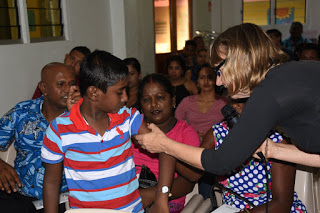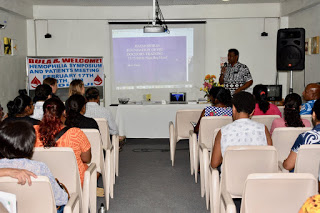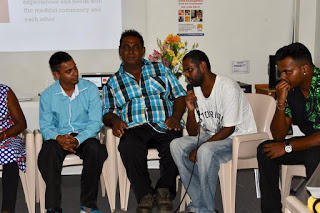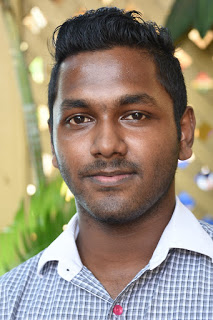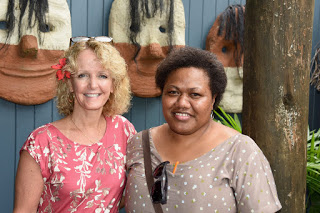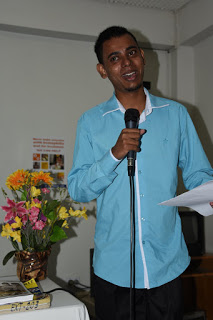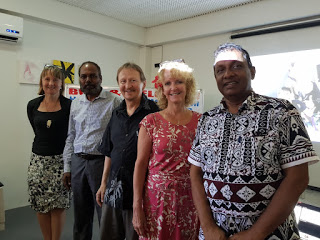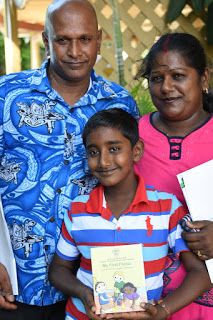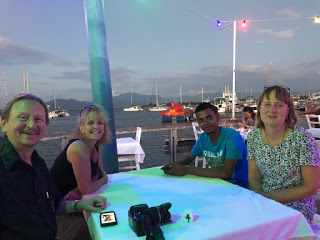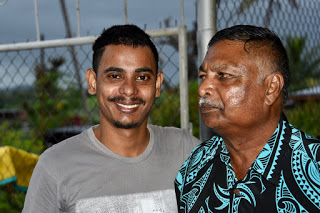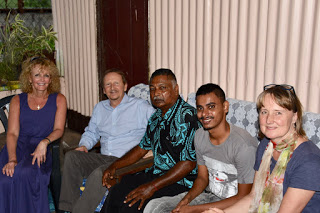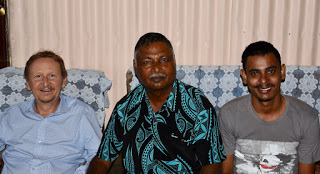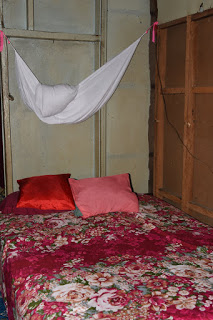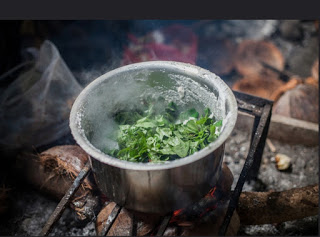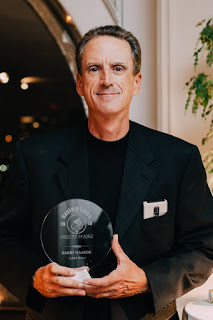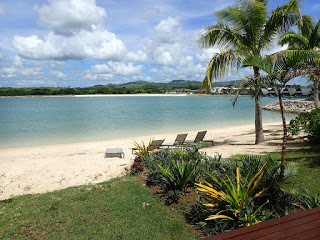
I can honestly say a cold sore led to the forming of the Fiji
Haemophilia Foundation. Yup. More on that in a minute.
Fiji… the very name conjures up sun-soaked beaches, palm trees,
turquoise waters, and friendly people. When I told people I was headed to Fiji,
some rolled their eyes, like Work is so
tough, isn’t it? Well, it’s cyclone season, and we did have work to do. We’re
holding the first ever hemophilia workshop, and starting a national foundation
for hemophilia. Not much time for beaches!
My thanks to two people on Facebook—Kelley Lynn Gonzalez and Milena
Pirnat— who sent to me a young man with hemophilia, Kunaal Prasad, in need of
factor. We get many requests daily and try to help ship factor to all in need.
But when I learned Fiji had no hemophilia care, that they still used cryo and
fresh frozen plasma, and that Kunaal was a bright, articulate and eager to
learn young man, the pieces fell into place. No one from the world hemophilia community
had ever been to Fiji in an official capacity, until now.
Kunaal (and Fiji!) got his first shipment of factor from Project SHARE,
but the physicians were reluctant to infuse it. Kunaal, ever resourceful,
appealed to the interns, young budding physicians, who infused him, with me
coaching half a world away at 1 am. That’s not sustainable. So I invited Dr.
Julia Phillips, a hematologist from New Zealand, to accompany us to Fiji to teach
about hemophilia. Randall Curtis, a man with hemophilia and an international advocate (and a personal friend),
would also accompany us. He had visited Fiji just the year before, when Cyclone
Winston hit the islands.
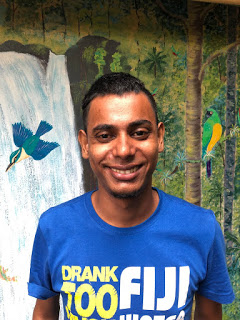 |
| Kunaal Prasad |
This is where the cold sore comes in. Randy was vacationing with his
family, was stuck due to the cyclone, and ran out of cold sore medicine. The
one doctor he was able to see, Dr. Bijend Ram, prescribed him his medicine,
and then learned a lot about hemophilia from Randy that day. When they both realized
there was substandard care in Fiji, they both set about trying to set up a hemophilia
foundation. Dr. Ram made some progress but it stalled.
Until Kunaal contacted me. Setting up new foundations is what I do.
You need a committed doctor (check) and a patient leader. In Kunaal, I think we
found one.
Here’s part one of our trip.
Tuesday
February 13, 2018
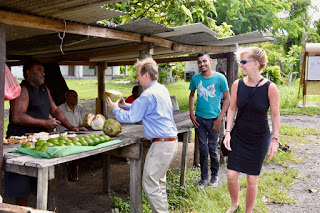 |
Randy Curtis makes us all laugh as we get
coconuts en route to Suva |
We’re catching the tail of a cyclone that hit another island in Fiji. It
was overcast and very windy, with sheets of intermittent rain all day. Kunaal
and his father pulled up in their car at 8:30 am to transfer me to the Nadi Bay
hotel, a quaint little hotel near the airport. His father Jack is a big guy,
over 6 feet, and Kunaal is taller than he looks on Facebook. After intense
Facebook correspondence and emailing for four months, we were delighted to finally meet! Kunaal came up
to my room while his father had to leave, so we chatted a long time and
I heard his life story, which is very sad. His older brother died at age 7 of a
nosebleed; Kunaal himself had a brain bleed, and was in a coma. Such an articulate,
handsome youth, age 23. I wince at the stark difference: his life
here and our lives in the US… and look at what this young man has accomplished!
He brought us three here: me, Randy, and Julia Phillips (a hematologist from
New Zealand), because we believe in him. He has leadership skills and a vision.
Life has been hard, but he is resilient.
It was a day to get acquainted (though I’ve known Randy about 20 years)
and to do errands. Hotel drop off, then off to lunch in Nadi, at “Victorious Apple
Restaurant,” featuring Chinese cuisine. (Nadi is pronounced “Nendi,” with a silent “n” as
we are told) Afterward, we drove a short distance to the Paper Power store to
get items for our workshop on Sunday. Julia had nowhere to park, so she drove
around, got lost and we had to wait for her in the searing sun, trying to reach her by cell.
Finally we took a taxi to where she was!
She’s a good sport!
We drove back to the hotel, where Randy taught Kunaal how to infuse
himself. I do believe Kunaal became the first person in Fiji to self-infuse at that moment. I had to prop my feet up on the wall for 30 minutes as they were
swelling terribly in the humidity.
At 7 pm off to the “sign man”; it was a short drive but the visit was long.
The house on the outside appeared ok, a saltbox, but inside, it was a conglomeration
of rugs, chairs, baby things. The rugs were laid down, wall to wall, without
being cut or nailed. There was furniture, long since stained. Stuff was
everywhere, as this was his workplace and home. I admire the guy for eking out
a living here. And with this weather, everything is damp and dripping. His
mother appeared, an elegant, though poor, woman, wearing black, with a distant
look in her grey eyes. She shook our hands politely and her frail hand felt like the damp
paw of a kitten.
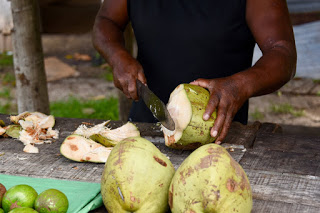 |
| Chopping coconuts along road |
Kunaal was tired and hurting; I could see it in his face. But we had
to wait a long time to check the sign (which was accessed through the grindingly slow internet).
I paid Sign Man $50 Fijian dollars (about $25) and stood up to announce
that we needed to get back. It was 8 pm and we were all tired. And we had to
take Kunaal home and that became an adventure!
Driving in the dark, about 15-20 minutes, through Nadi, then to the
outskirts of the town, we took a left and down a steep dirt road, with many
potholes from the rain, rocks, more potholes… we were swallowed up by high
grass bordering the dirt road. Then across a rushing river on a concrete,
narrow bridge, and a sharp right, onto railroad tracks! Kunaal said to just
stay on the tracks and we won’t get stuck in the mud. The mud was 6 inches deep
at least. If we got stuck… how would we get out? Only when the mud spat us out
onto dirt and rocks again did I breathe. We pulled into a small area where
there were a few small homes and three barking, yellow mutts. Don’t touch them,
Kunaal warned. We piled out and were warmly greeted by Kunaal’s family. His
mother is pretty! We hugged. His sister was there, her two little kids are
adorable. They all live together in a two room house. The mosquitoes were
relentless. It’s difficult to imagine Kunaal living in such an out-of-the-way
place, with a bleed, dealing with cyclones, mud, floods mosquitoes.
Click here to read about Wednesday’s visit to see the oldest person
with hemophilia in Fiji.
Thursday February 15, 2018 Trip
to Suva
Today we would go to the capital,
Suva, to meet with staff at the Colonial War Memorial hospital, and also the
Ministry of Health. The day started out sunny and hot. Julia, Randy and I met
in the lobby with Kunaal. Dr. Ram would meet us in Suva.
En route, we stopped along the sea,
which was bright and beautiful, and the others had coconut milk straight from a
roadside vendor. Randy’s a lot of fun as he just chats up a storm and jokes
with everyone! We took photos and then resumed, with me driving on the left,
for the first time!
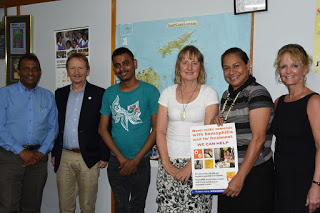
Once we got near Suva, three hours
later, I relinquished driving to Julia, who, from New Zealand, always drives on
the left. Suva is small and quaint. We found a restaurant and met up with
Roshika Deo, a lawyer who has volunteered to help Kunaal. I instantly liked
her: age 35, single, dynamic, smart, articulate. She will prove to be
instrumental in all we do. We waited for Dr. Ram who eventually appeared, and
we all sat down to a hearty lunch. The food is fantastically great. My favorite
was Kokoda (
kore-condaa), which is
fresh Mahi Mahi in lemon juice. We discussed our goals and plans and
relaxed.
Off to the Ministry of Health. It’s a
simple building, with easy access and like many, plastered with posters on
child health, immunizations, birth control, clean water and blood borne
diseases. We met Dr. Luisa Cikamatana, director of hospital services, who,
after introductions, asked simply, “What can we do for you?”
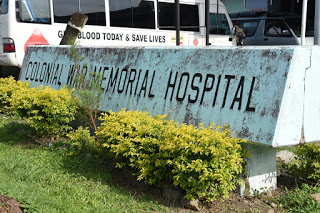
We wanted to be sure our first visit
was favorably memorable, so I replied, “Nothing. We don’t want anything. Just simply,
keep us on our radar. If we need help getting medicine from customs, help us. If
we need your approval, please give it.” And I gave her a run down of what we were
trying to do. Basically, let us help Fiji for now, and don’t impeded our help.
We took photos and that was that!
Then off to the Colonial War Memorial
hospital. This is a government funded, teaching hospital, quite aged. Like many
hospitals in developing countries, the halls had plaster missing in huge
patches, and stained walls. There are 512 beds, but most of the care is free. We
met with Dr. Illisapeci Veneti, a pediatrician. She said she has nine children with hemophilia;
I immediately looked at Kunaal and said, “This is how you build your database
and registry. Ask if you can have them contact you (and later, after we left,
their emails confirmed this).”

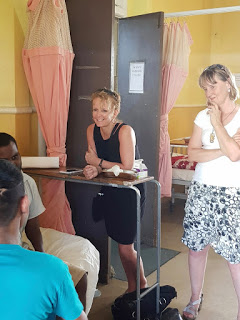
Then the highlight of my day: we met Niraj, a 23 year old who was
admitted a week ago. His ankle was bleeding and he couldn’t walk. He had been
in so much pain, he looked older than his years. His bed was rumpled and sad, in the corner, surrounded by
yellow walls that were dirty and chipped. He showed me his hand: rigidly
gripped, like a Volkmann’s contracture due to nerve and muscle damage. I am
reminded each time I meet a patient, how lucky we all are in the US, how my heart breaks
for these guys, and how much work we all have to do.
We had brought factor, and so Dr. Julia used this as an opportunity to
do a demonstration about infusions. It was great.
She had the nurses gather, got permission from the head physician, and had the
local nurses themselves mix and administer the factor. Everyone was happy!
Kunaal spoke and length with Niraj and even after everyone was walking out the
door, I still wanted to talk to him and take photos, which I did. Kunaal and I
both agreed there was something special and heartfelt about Niraj. His
condition bothered us both a lot, and he himself was so grateful and humble.

It was getting late and we still had a three-hour drive back to Nadi. After
a while I offered to drive and Julia was only too happy to have me take over. It
was odd, trying to remember to use the blinker (on the right), the high beams
(on the left) and the shift (on the left). Dr. Ram was a bit nervous! He kept
reminding me, “Beams!”
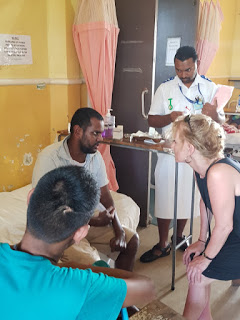
The rain sometimes came down in sheets, making it hard to see. And
there were killer potholes, that appeared at the last moment, making huge
explosive sounds. Imagine having a flat in this monsoon-like weather! I navigated the potholes, the roundabouts, the rain.
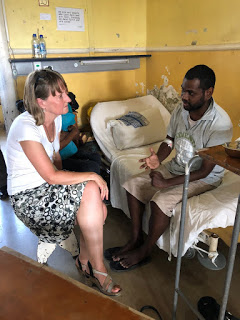
Then out in my peripheral vision, I saw something move across the
blackened street out of the pouring rain… looking like a crawling face hugger
from Alien. Later on, I saw the high beams bounce off of something by the side
of the road: a huge red crab! I realized that these were all land crabs coming out
on to the road in the rain.
We arrived safely, and it was back to our little motel for wine and
beer… and brainstorming.
Next week: A new era in Fiji!
